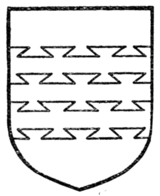would have these placed at equal distances from each other; but a coat with two bars gemel would be depicted with two of its barrulets placed closely together in chief and two placed closely together in base, the disposition being governed by the fact that the two barrulets comprising the "bar gemel" are only one charge. Fig. 119 shows three bars gemel. There is theoretically no limit to the number of bars or bars gemel which can be placed upon the shield. In practical use, however, four will be found the maximum.
 Fig. 117.—Bars raguly. |
 Fig. 118.—Bars dovetailed. |
 Fig. 119.—Bars gemel. |
A field composed of four, six, eight, or ten horizontal pieces of equal width is "barry of such and such a number of pieces," the number being always specified (Figs. 55 and 56). A field composed of an equal number of horizontally shaped pieces, when these exceed ten in number, is termed "barruly" of such and such a number. The term barruly is also sometimes used for ten pieces. If the number is omitted "barry" will usually be of six pieces, though sometimes of eight. On the other hand a field composed of five, seven, or nine pieces is not barry, but (e.g.) two bars, three bars, and four bars respectively. This distinction in modern coats needs to be carefully noted, but in ancient coats it is not of equal importance. Anciently also a shield "barry" was drawn of a greater number of pieces (see Figs. 120, 121 and 122) than would nowadays be employed. In modern armory a field so depicted would more correctly be termed "barruly."
Whilst a field can be and often is barry of two colours or two metals, an uneven number of pieces must of necessity be of metal and colour or fur. Consequently in a shield e.g. divided into seven equal horizontal divisions, alternately gules and sable, there must be a mistake somewhere.
Although these distinctions require to be carefully noted as regards modern arms, it should be remembered that they are distinctions evolved by the intricacies and requirements of modern armory, and ancient arms were not so trammelled.
